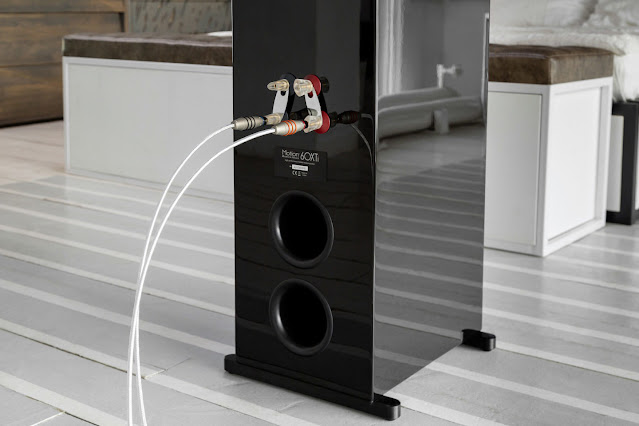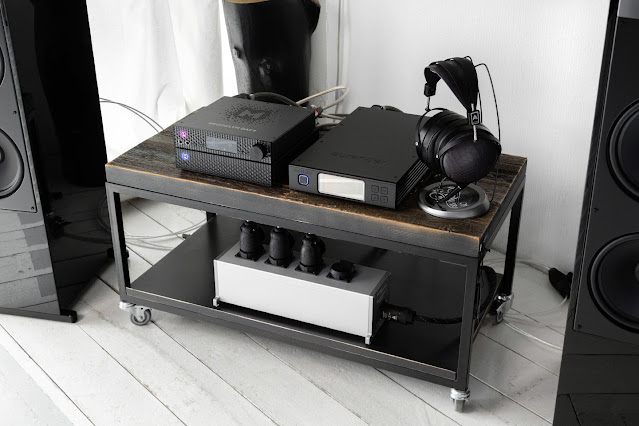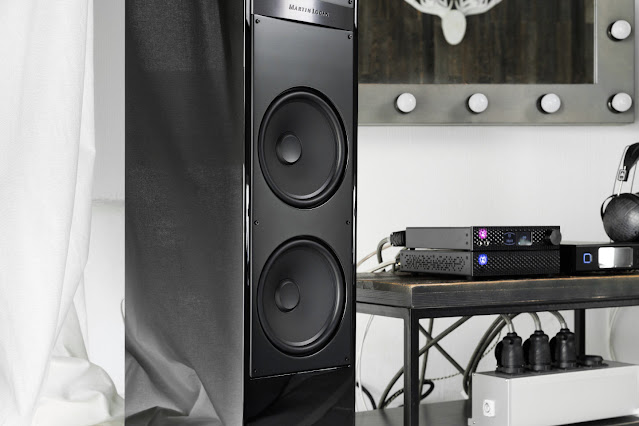MartinLogan Motion 60 XTi Test
Comfort and Drive
It seems that there is no such lover of high-quality sound left who has not heard about electrostats from MartinLogan - the company's assortment includes many models based on this technology, and we have already done a lot of tests . However, the "old school" should not be discounted, because the classic layout of three-way speakers with traditional (at least partially) speakers is more than relevant to this day, and sometimes no less able to surprise the listener. The MartinLogan Motion 60 XTi is a good example of this classic layout.
Large exterior, meaningful interior
First of all, the 60 XTi impresses with its size. Far from small floorstanders inspire respect at first sight.
Naturally, with such dimensions, the MartinLogan designers could afford not to spare inches for the radiators: the first to attract attention are two massive bass drivers, which are loaded by the corresponding number of phase inverters located on the rear panel.
The low-frequency section, according to the manufacturer, has an isolated asymmetric inner chamber with a high level of damping to allow the 8-inch drivers to deliver the lowest possible frequencies to the listener. Their diffusers are made of aluminum, decorated with concave dust caps and supported by cast aluminum baskets.
The entire low-frequency section is located with a significant offset to the bottom of the speakers. This arrangement, according to the manufacturer, helps to minimize the reflection of low frequencies from the floor.
The midrange driver, which is located higher, differs from the low-frequency section, first of all, in size. But even 6.5 inches for a midrange is not small, many floorstanders use drivers of this size to sound the bass.
Otherwise, it is the same aluminum diffuser with a dust cap, but with a basket molded from polypropylene. According to the calculations of engineers from MartinLogan, such material in the manufacture of the basket contributes to the displacement of resonances in that part of the range that is outside the range of the midrange.
All these charms are also placed in an isolated cabinet, so that the impressive bass section does not make its own adjustments here, and the midrange driver itself, in turn, does not interfere with the tweeter.
At the top of the front panel is MartinLogan's proprietary ribbon tweeter called the Motion XT. Outwardly, it is always recognizable - the usual "accordion" under the grill, which in this case is somewhat recessed into the front panel and framed by a thin edge of the waveguide.
Combining all the emitters in the speaker system is engaged in the crossover developed by MartinLogan, which is named after the engineer-inventor - "Vojtko". This crossover design is designed to minimize the amount of detail in the signal path.
To make this idea easier to implement, even at the production stage, the speakers are matched to each other by measuring their physical characteristics for maximum compliance. Probably, thanks to this approach, two additional protection circuits were also able to be placed in the crossover circuit - from excessive currents and overheating.
Visually, the MF/HF section is separated from the woofers by a rectangular metal décor detail with the name of the manufacturer.
In general, the entire front panel looks strict and may well appeal to lovers of the classic appearance of speaker systems. It is painted matt black and exactly matches the tone of the diffusers. A variety of tones are added by a yellow ribbon tweeter and a silver label sword.
Of course, if desired, protective grills can hide all this, but the sword will remain with you: two independent grills are joined to it and form a relatively flat surface.
The remaining faces of the large exterior are varnished and pristine, with the exception of the back side. Here, in its lower part, there are two pairs of gold-plated terminals for connecting acoustic wires and, as mentioned earlier, a pair of bass-reflex ports.
The top panel completes the list of design solutions - it slopes from the front panel to the back. When viewed from the side, it seems that the speakers have a trapezoidal case.
To keep the 60 XTi upright, the spikes protrude slightly beyond the perimeter of the hull. But this is a common practice for floorstanding speakers, and given the considerable size of this model, it is even necessary. Although, if you are sure that your Motion 60 XTi are completely safe, these same spikes can be mounted directly on the speaker cabinet, or you can replace them with rubber feet.
It is also worth mentioning that the cases are made in three colors: black gloss, white matte satin and red Canadian walnut. But in all cases, the front panel will remain matte and black, and the sword - silver.
Components
With just their appearance, the MartinLogan 60 XTi tells the listener: “Get ready! Will now be…!" But for the 60 XTi's words to be true, they need the right companions.
So, the amplifying link was used Mytek Brooklyn AMP , which, despite its modest dimensions, is ready to control much more complex speaker systems. His colleague Mytek Brooklyn DAC + simultaneously worked as a DAC and preamplifier , and the streamer / server Aurender W20SE was engaged in supplying the system with a digital signal.
Here is such a company gathered around the Motion 60 XTi. Out of the range of rack-mounted audio components, she had no problem keeping the 60 XTi in line throughout the test.
big sound
Listening started from that position of the "listener - AC" system, which, at first glance, did not quite correspond to the layout of the right triangle. I had a fairly spacious room at my disposal, so the test began with the search for the correct speaker placement, in my opinion
In the initial position, the distance between the speakers was no more than two meters - while the listener's position was in the region of 3–3.5 m from the AC line. With such an arrangement, the music from the Motion 60 XTi's speakers poured into the listener in an unbridled wave and pressure, leaving not much room for building a scene.
But the first impression is the most important. The size of the 60 XTi did not deceive - behind these hefty dimensions lies the same big sound! And he will obviously be cramped in a small KDP.
There were also concerns about the height of the tweeters: when a listener sits on an ordinary sofa, they are much higher than the level of his head. But, as practice showed (and then data from MartinLogan), their tweeter has a wide directivity angle in the vertical plane, and the listener's displacement in the same plane practically does not change the perception of high frequencies.
In order not to bother the reader with analyzing the peculiarities of the Motion 60 XTi sound in different positions relative to the listener, let's immediately move on to the part of the test where there are about 3 meters between the speakers and they are directed at the listener, to which the speaker line is about the same distance.
right triangle
Right triangle - right music. The Baba Blues team came in handy here. According to the first impressions - absolutely natural tonal balancing of the guitars, the vocals sounded quite familiar and recognizable.
In the new position, the 60 XTi built a proportional, tangible soundscape with recognizable positions of vocals and instruments. The low-frequency range showed good compatibility with blues compositions - plucking on the strings could really be felt with the chest, and not just heard.
Jazz and its derivatives were turned to to see how the Motion 60 XTi would react to having more than two instruments in a recording. And here they did not fail: all the instruments are clearly distinguishable and are presented to the listener with a sense of their volume, without excessive separation of the sound canvas into components.
Low frequencies in this case played out just as accurately, with a sharp attack, and in some jazz compositions there was an excess of this sharpness. Perhaps, sometimes I even wanted some impressiveness, but the strong reins of the Brooklyn AMP strove to squeeze the maximum accuracy and attack out of the bass.
It is also worth highlighting the vocals - there are plenty of emotions in it! Although the female vocals in some compositions lacked the “sparkle” and airiness that lives in the high frequency zone, the rest of the range is filled with overtones to the brim.
On the other hand, this feature of playing high played a plus when listening to songs from heavy genres. They are played with the utmost intelligibility and pressure, while mixing flaws are minimal, and in some places they did not interfere at all with getting their portion of drive. The effect of listening to Guns N` Roses on the 60 XTi is impressive - you want to put on a leather jacket, sit on a Harley Davidson and drive off into the sunset, taking the 60 XTi with you.
The development of the low-frequency range from the side of speed characteristics is beyond praise. Lamb of God with the composition "Memento Mori" will not let you lie: the rhythm of the drums can be traced to the last beat, none of them drowned in the abyss of guitar riffs.
High frequencies as a reason for a separate chapter
An attentive reader should have noticed that almost all the ranges have already been sorted out, but the high frequencies have so far remained on the sidelines. Let's restore justice by highlighting a separate chapter for their discussion. What's more, they deserve it!
For the first time in today's test, high frequencies attracted attention when listening to excellent orchestral recordings from Kenichi Tsunoda Big Band. In most of their tracks, high frequencies are recorded with approximate quality and extend far beyond the limits of the human audible range.
Of course, this is too much, given the threshold of 25 kHz in the 60 XTi and the upper limit of 16 kHz in my hearing. But even this threshold of perception is quite enough to feel the level of high-frequency processing in the MartinLogan Motion 60 XTi. And this level is quite high.
According to first impressions, there are not so many high frequencies quantitatively. Perhaps less than I'm used to hearing. However, after some time, the understanding comes that the stake here is on their quality, and the quantity turned out to be exactly such as not to become intrusive and not pull the blanket over yourself.
When the ear adapted, it presented a diverse world of percussions that have body, pure tone and true attenuation. And the delicacy with which the Motion XT driver opens this world to the listener is sometimes mesmerizing. It was beyond me to interrupt listening to the track "Hush-A-Bye" by Jonny Griffin.
The delicacy of this range is also expressed in an interesting moment: when the recording has "roughness" in the HF region, in most cases they will be skillfully worked out without harming the listener by focusing on them.
In general, high frequencies of this quality have become a good complement for emotional, sometimes intimate mids and accurate bass.
Conclusion
It seems that the MartinLogan Motion 60 XTi is quite capable of opposing itself as a driving and delicate alternative to the “flashy high-end”. These speakers are clearly headed by comfortable, long, rhythm-filled listening, which will not tire you with excessive harshness and unnecessary accents, but will allow you to fully enjoy any genre with a glass of your favorite drink. At the same time, the detail of the sound and the nuances will not only not hide from the attention of the listener, but will also add zest to the overall emotionality of the sound.
Pros
elastic, precise, weighty bass; full-bodied, emotional sounding of medium frequencies; high frequency quality; delicate correction of recording flaws
Cons
relatively high cost; in some compositions - excessive sharpness of the bass; sometimes lack of "air" in female vocals
OFFICIAL SITE
SPECIFICATIONS MartinLogan Motion 60 XTi
Type: Bass reflex passive floor standing speakers
Number of bands: 3
Tweeter: 1 pc., Motion XT ribbon driver, 115x70 mm.
Midrange driver: 1 piece, 6.5", aluminum cone, polypropylene basket, internal closed chamber loading
Woofer: 2 pcs., 8", aluminum cone, aluminum basket, unbalanced internal chamber load with bass reflex
Frequency response: 35Hz - 25kHz (±3dB)
Sensitivity: 94 dB/mW
Resistance: 4 ohm
Colour: black gloss, white matt, red walnut
Dimensions: 290x1 218x366 mm
Weight: 30 kg
























.jpg)



0 Comments